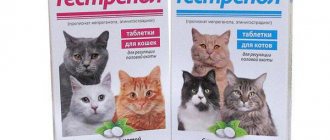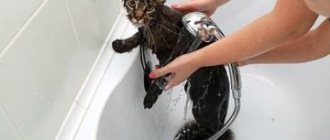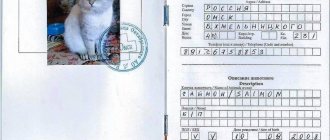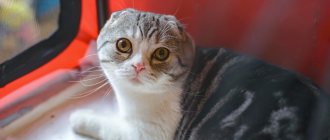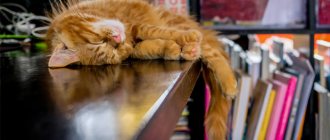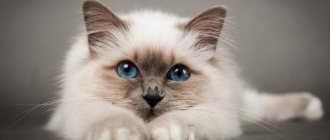What do you need to participate in the exhibition?
Any cat that meets the conditions of one of the registration organizations can take part in the exhibition.
Age
Usually, if a kitten has reached 3-4 months, he is gladly accepted as a candidate. But kittens that are younger than this age are accepted only with the kitten’s mother as part of the litter. There is no age limit for an animal to participate in an exhibition, but it is not recommended to take a cat over 10 years old to such events.
If you are going to use your pet for breeding, remember that in this case they will only be able to evaluate it from 10 months. Until this age, a cat can participate in exhibitions, however, after 10 months, any pet that is recognized as suitable for participation in breeding is presented to the exhibition again.
Health
It is very important that the cat is completely healthy:
- Vaccinated against rabies, panleukopenia, calicivirosis and rhinotracheitis no earlier than a year and no later than one month before the exhibition.
- Dewormed with a broad-spectrum drug.
- The cat should not be injured by people or other cats. An animal that shows a minor injury, such as a scratch, bite, or abrasion, may lose several precious points when judged by the experts. And if there are significant injuries, the pet may be completely removed from participation in the competition.
- The animal must not have congenital defects - strabismus, bald spots, blindness, cleft lip, etc.
- A pregnant cat is only assessed until it is noticeable in appearance - approximately 5 weeks.
- Nursing cats are also taken to exhibitions. However, noticeable signs of lactation can significantly reduce the score.
- Neutered and spayed cats can only take part in classes that are available to them.
So, if your cat meets all of the above requirements, think about whether the animal will be able to visit such crowded places. Often unsociable and shy cats, when surrounded by a crowd of unfamiliar people and animals, loud noise and strange smells, experience very severe stress. And, most likely, there is no point in wasting your time and money in this case. After all, if a contestant hisses or scratches an expert, he will be disqualified.
XI International Cat Show “Grand Prix Royal Canin”
If you are convinced that your cat is the future star, start collecting documents and preparing the cat for the exhibition. Now you must realize that you are taking on some responsibilities and financial costs.
Required documents
- Veterinary passport. Each animal, regardless of whether it is purebred or not, must have its own veterinary passport, which must contain records of all injections and treatments for parasites.
- Certificate of form No. 4. For the exhibition, you should issue a certificate of form No. 4, which is issued on the basis of a veterinary passport and a clinical examination of the cat - an assessment of the appearance of the animal.
Additional documents if you are planning to travel to an exhibition out of town
Certificate form No. 1. The certificate will indicate the sanitary and epidemiological situation in the area of your residence.
These certificates must be issued at a state veterinary clinic.
When issuing any certificate, keep in mind the fact that it is valid only for 3 days from the date of receipt.
Additional documents if you are planning to travel to an exhibition abroad
You need to obtain an international veterinary passport.
If your cat is purebred, you will need to have documents with you confirming this:
- contract of sale,
- kitten birth metric
- pedigree
Basically, such documents are drawn up and issued immediately after purchasing a purebred kitten.
For the first time, it is better to participate in an exhibition that is located near you.
The Supreme Cat Show is the world's largest cat show, held annually in Birmingham. 2010
Other little things
It is advisable to fill out the form and submit an application for participation at least a month before the opening. It is very important to fill out the form correctly: indicate the exact gender, age, breed, coat color, nickname, etc.
In case any questions arise, the telephone number and name of the administrator should be indicated on the first page of the form.
It is recommended to check the cost of a cat show in advance. Usually the amount ranges from 600 to 2200 rubles. depending on the rank of the event. You may need to pay the exhibitor fee in advance.
In addition to personal data in the form, you will need to select the appropriate exhibition class, which is divided depending on the exhibition system in which your pet will take part.
Preparing the appearance
Grooming is an important element of preparing a cat for an exhibition; it emphasizes the thoroughbred and beauty of the animal.
Taking care of your pet’s appearance begins not a day or two before the event, but from the birth of the kitten. The cat is washed occasionally (or when it is very dirty), but depending on the length of the coat, it is combed 1-2 times a week. Regularly clean the animal's ears and eyes, trim its claws, and remove tartar.
Before the exhibition, all these procedures are mandatory in full; they must demonstrate the merits of the pet in the best possible way.
Cat Show Systems
All cat exhibition systems are divided into 3 types:
- European
- American
- British
Each system differs in judging methods, show classes, titles and much more.
European system
The wcf system is one of the European ones, which is currently considered the most popular in Russia. It is known for the fact that its experts are relatively loyal to new breeds and quickly recognize them. In addition, according to the wcf system, the cat is accompanied by the owner throughout the entire exhibition, which, you see, is important for a pet. Score sheets and diplomas at such an event are issued only after the exhibition. European exhibition systems also include fife, ofa, farus, mfa, wacc.
American system
The American exhibition system is distinguished by the fact that experts do not evaluate cats on tables. There are rings where cats are described verbally. And instead of evaluation sheets, participants in such exhibitions are given ribbons called ribbons. According to the American version, systems such as tica, cfa, cff, icu, rui and wca work.
British system
The British system is not as popular as the European and American ones. There is only one system here - gccf, which evaluates cats sitting in cages.
The origin story of the “Siamese princess” is surrounded by beautiful legends, speculation and intrigue. There is a legend about Thai princesses who, while bathing, strung their rings on the tails of the royal cats. This is how the Siamese cat's tail defect is explained. But to this day, not everyone knows that this trait is not an adornment of the breed, but its misfortune. It is also unknown how the Siamese cat came to Europe and where its true homeland is. There is a version about a high honor bestowed upon an English subject who was given a pair of Siamese cats by the royal family. Along with this, traces of these cats are not traced in the monastery of the Siamese king. What is the actual truth? Only they know this. Wise, sophisticated, mysterious blue-eyed Siamese cats...
As for the facts, the first pair of Siamese were actually brought to England by British subjects from Thailand. And it was there in 1871 that she was first shown at the first ever cat show at the Crystal Palace. In the exhibition catalog that has survived from those times, there is a description of two representatives of this breed. A year later, an article was published about Siamese cats entitled “Oddly Colored Shorthaired Cats.”
And although all the stories about the origin of these cats are unconfirmed, one thing is certain - Siamese cats have existed in Siam for a long time. However, where can one deal with cats if the history of ancient Siam itself is shrouded in mystery? Colonization, wars... Unlike neighboring countries, justifying its second name - Muang Thai (Land of the Free), Siam has never been anyone's colony. During the reign of 33 kings, its capital Ayutthaya became one of the largest cities in the world. Perhaps Siamese cats were a common pet among the inhabitants of the ancient city. After the ascension to the throne of General Chakri, who laid the foundation for the reigning dynasty and was named Rama I, the modern capital of Thailand, Bangkok, was founded. Its National Library houses authentic manuscripts of ancient Ayutthaya. In the manuscript stored there, known as “The Book of Poems about Cats,” among the descriptions of the cats of this country there are Siamese. Magnificent miniatures depicting cats with dark brown markings on the face, ears, paws, tail and a wonderful light body color present to our contemporaries the appearance of Siamese cats of those times.
As for the status of the Siamese cat in ancient Thailand, there are many versions on this matter. One of them suggests that these cats in the past belonged exclusively to the kings of ancient Siam and enjoyed special privileges. Their export was strictly prohibited and punishable. And only in case of special encouragement of his subjects for faithful service or services rendered could the king give them a Siamese cat. However, similar versions exist in relation to other eastern breeds of this Indochinese Peninsula. Korat, Burmese, Siamese... Which of them was really awarded the honor of being a royal cat? The information is contradictory... Be that as it may, all these breeds have identical exceptional qualities - special, unique beauty, nobility of soul, extraordinary intelligence and truly “dog-like” affection for humans. Among them, slender, chiseled Siamese, striking with their “sculptural” beauty, are deservedly called “princes of the cat kingdom.”
However, it would be a misconception to say that Siamese cats originate exclusively from Siam. Similar cats were found in other regions of Southeast Asia. And not only there. Peter Simon Pallas was a German biologist, geographer and traveler. Studied in Germany, Holland, Great Britain. Having moved to Russia in 1767, he was elected academician of the St. Petersburg Academy of Sciences. In 1768-1788 he led the expedition of the Academy of Sciences, which traveled from Eastern China, through Mongolia, Altai, the Urals, to the Caspian Sea. During his travels, Peter Simon collected (and subsequently processed) a huge amount of geographical, geological, botanical, zoological, ethnographic and other materials. Pallas published the results of his research in a book, which, following the fashion of the era, bore the very detailed title “A Journey through the Southern Provinces of the Russian State in the Period 1773-1788.” In the area of the Caspian Sea, near the settlement of Insar, Pallas met a cat similar in description to the Siamese: “This cat is of medium size, it has longer and thinner legs than those that we are used to seeing in an ordinary cat, it has a long and narrow head . The tail is 3 times longer than the head. The coat color is dark brown, similar to the color of mink, but richer on the face and tail and lighter on the sides and belly. On the chest there is a white medallion. The nose is covered by a black mask that also surrounds the eyes and ends in a pointed triangle on the forehead. The ears, paws and tail are very dark in color. The texture of the coat is more pleasant than that of an ordinary cat, and resembles the smooth, shiny fur of a mink. The undercoat is soft and lighter in color. The hair on the tail is short, smooth, and close-fitting.” The cat from the engraving illustrating these notes also resembles the Siamese cat from the miniatures of ancient Ayutthaya.
Thus, we can only assume that the homeland of the Siamese cat is indeed Thailand, but we should not be absolutely sure of this.
We return to England in 1885. Reports at the time about the Crystal Palace cat show claimed that it was the largest exhibition of those years, attracting approximately 480 participants. A pair of Siamese named Pho and Mia (which means Father and Mother in Thai, owner Mrs. LJ. Ve1ey-Gou1d), who by this time had already given birth to three kittens, became a sensation at the show: they won the champion titles. Mia was "Best Shorthair in Show", "Best Club Shorthair", won the NCC (National Cat Club) Gold Medal and the Wedgwood Tea Service presented by the Crystal Palace to the Best Shorthair in Show, and Pho was second in all of these. nominations. Unfortunately, this was their only triumphant performance. Soon after the exhibition they died.
Reports at the time about the Crystal Palace cat show claimed that it was the largest exhibition of those years, attracting approximately 480 participants. A pair of Siamese named Pho and Mia (which means Father and Mother in Thai, owner Mrs. LJ. Ve1ey-Gou1d), who by this time had already given birth to three kittens, became a sensation at the show: they won the champion titles. Mia was "Best Shorthair in Show", "Best Club Shorthair", won the NCC (National Cat Club) Gold Medal and the Wedgwood Tea Service presented by the Crystal Palace to the Best Shorthair in Show, and Pho was second in all of these. nominations. Unfortunately, this was their only triumphant performance. Soon after the exhibition they died.
Further breeding of this breed continued with the acquisition of many new color variations and improvement of the exterior. It should be said that there are only two breeds that rapidly change their original appearance: Persians and Siamese with Orientals (which are a colored variation of Siamese). It is here that breeders in their work strive to achieve the most extreme (extreme) manifestations of any characteristics. It is interesting that Persian and Siamese cats are complete opposites in their appearance.
Selection work with Siamese is aimed at preserving their exotic features: emphatically exaggerated elegance, lengthening all its lines, which naturally entails lighter bones, lengthening the wedge of the head and the formation of a straight profile. Everything about this cat should be as elongated and long as possible - legs, torso, tail and even ears. However, these are no longer ears - this is an “obsession” of the breeder’s creative self-expression. Moreover, the entire animal must be not only graceful, but harmoniously and proportionately balanced. It is this appearance of the modern Siamese breed that is determined by the standards of Europe and the USA.
And only some owners of Siamese cats, adhering to the old standard in their breeding, did not join the race for elegance. As a result, part of the Siamese cat population remained virtually unchanged. Such Siamese are called “non-traditional” or “apple-headed”. In American associations (CFA, AGFA) they exist as an independent breed, although they do not have final official recognition.
As for the color of Siamese cats, the effect of acromelanism (coloring of certain areas of the body) that determines its manifestation is widespread in the animal world. A number of mutagenic, recessively inherited alleles of the C (colour) locus, and in particular the Cs allele characteristic of Siamese, determines the synthesis of thermolabile tyrosinase, in other words, active only at elevated temperatures. This is why only the coolest parts of the body are colored in animals. To name this phenomenon in the world of “cat breeders”, preference was given to the English term “color-point”. The terms “acromelanism” and “Himalayan albinism” have not been established in felinology.
But let's return to the Siamese color mutation. Taking into account the fact that the Siamese color gene affects only its distribution throughout the body, but not the color as such, these areas can be colored in any way (solid, silver, tortoiseshell, tabby). Therefore, there is no big problem from a genetic point of view than getting Siamese markings of different colors.
The first Siamese cats brought to England had the seal point color, which in English sounds like “seal” (seal). A color that resulted from the effect of the Cs allele on the normal black coat color. Only under the influence of this gene did the black color turn into dark brown.
There is an assumption that Siamese cats brought to England were initially carriers of a blue color, which they may have had in their genotype from “unofficial” connections (for example, with a Korat). Therefore, already in 1894, the first Siamese cats with blue markings (blue point) were obtained. It cannot be said that their appearance was greeted with enthusiasm. At first they were treated as “spoiled” or “wrong” seal point cats. For example, during the Holland House show in 1896, the famous judge Lewis Vane removed a blue point Siamese cat from the ring, arguing that it was an atypical color cat and could not be considered a Siamese. It was only in 1936 that the GCCF (Governing Council of the Cat Fancy), the most authoritative felinological organization in Great Britain, recognized the blue point color, assigning it a number and champion status. Thus, more than forty years passed between the first appearance of blue point at an exhibition and the official recognition of this color!
The later Siamese with chocolate markings were also perceived by the British as low-quality sealpoints. There is a version that this color was obtained as a result of crossing the daughter of Wong Mau - a Burmese descendant brought to the USA - with a Siamese cat. For a long time, chocolate point was not recognized, and only in 1950 did it receive champion status.
Also causing resistance from conservatives was the lilac point, a natural consequence of blue and chocolate. Recognized by American organizations in 1954, and in 1960 by the GCCF.
The number of recognized colors increased from exhibition to exhibition. However, sometimes they appeared not as a result of the purposeful work of breeders, but by the will of blind chance, threatening the loss of the achieved type. This is how the tabby point Siamese originated. Whether it is the owner or the cat who is “to blame” in this case, but the charming tabby-point kittens born as a result of an unplanned act of love between the Siamese “Juliet” and the street tabby “Romeo” (apparently, one of “Romeo’s” ancestors was a Siamese) aroused universal interest. Naturally, the matter did not end there. Ahead were new tabby point colors and their official recognition in 1966. Siamese breeders from different countries have become interested in tabby point colors. Still, most modern tabby point breeds are descendants of animals imported from England.
At first glance, it may seem that breeding new colors is not particularly difficult. However, the goal of breeders is not only to obtain the most complete spectrum of colors, but also to preserve the modern type of animal. And from this point of view, the possibilities for working with Siamese are almost endless.
Thus, over time, all the varieties of tabby point, tortie point, red point and cream point appeared, and now cinnamon point, lavender, caramel and fawn point.
More recently, smoke, or shaded point, has become widespread, which can significantly increase the existing number of colors in the silver and pastel range of colors.
The main requirements for all pointed colors are a clear contrast between the markings and the body of the animal, uniform tone of the markings and the absence of dark and white spots on the body. Excessive darkening of the coat and the associated loss of contrast, as well as uneven tone of markings, can be due to a whole range of reasons. First of all, these are hereditary factors, temperature and hormonal levels.
It is interesting that American standards consider only seal point, blue point, chocolate point and lilac point colors to be Siamese. All other colors are registered as shorthaired colorpoints. In addition, according to American terminology, tabby point is called lynx (lynx) point.
An important decoration of the Siamese is his amazing blue eyes. However, they are not always like this. The color of the eye can vary from pale bluish to deep blue, sometimes with a purple tint. But the deep dark blue color is recorded in the breed standard “china blue” (“Chinese blue”, perhaps by analogy with cobalt Chinese porcelain). It is no longer known what eye color was characteristic of the first Siamese that came to Europe. However, the breeding work of all breeders of this breed was aimed at establishing the “China blue” tone.
And although all colorpoints, due to a lack of pigment, under the influence of the Cs allele, have “blue eyes,” how important is their depth and saturation!
It is believed that in the 50s, most Siamese cats already had blue eyes. This assumption is made on the basis of the Oriental breed standard (which arose from the Siamese in the 50s and 60s). This standard prescribes green eye color for Orientals. At the same time, the practice developed of breeding Oriental cats with Siamese to improve the green color of the eyes in the offspring. It is now known that the shade of blue eyes in colorpoints depends on the different manifestations of the action of Cs alleles against the background of the original color. Green eyes become dark blue, copper eyes become bluish, yellow eyes become sky blue. In this regard, only blue-eyed, and not blue-eyed Siamese, could act as eye color improvers for Orientals.
There are also certain problems that are “close” to representatives of the Siamese breed (reflected in legends). These are by no means harmless “hooks” on the tail and squint.
As for “hooks,” it is generally accepted that these disorders are determined by the recessively inherited allele kink (hook). In homozygotes for this allele - kk - individual vertebrae acquire a wedge-shaped shape. It is these vertebrae fused together that determine the appearance of kinks, hooks or knots on the tail. However, they can have an effect on the entire spine, which can lead to pinched nerve endings, paralysis and other problems.
As for strabismus, this problem is interconnected with the Siamese color and is determined by the same Cs allele. It is interesting that the manifestation of this trait does not depend on the dose of the Cs gene, since oblique orientals heterozygous for Cs are often found. Many kittens are characterized by temporary strabismus, which subsequently goes away. It is believed that the Siamese's eyes are too close and deep-set to indicate a predisposition to strabismus. This may be true, but strabismus was also observed in traditional-type Siamese, regardless of the width and depth of the eyes. Quite often there are Siamese cats whose eyes begin to squint exclusively in stressful situations. A disqualifying sign is stable convergent strabismus. Such animals are excluded from breeding.
What influenced the consolidation of these characteristics in the Siamese? It is quite possible that these problems are a confirmation of the reality of the fact of “royal involvement” of these cats. After all, it was precisely the closed (isolated from the influx of genes from the outside) confinement in palaces or temples for several centuries that could play a role in the consolidation of alleles carrying these harmful traits. For a long time now, breeders have been selecting against these defects. And even if it is not easy to achieve success in this struggle, there are still centuries ahead...
The amazing grace, plasticity and refined beauty of the Siamese cat are not all of its advantages. The Siamese cat has an amazing character: it is smart, quick-witted and restless. The most important feature of her character is simply a unique attachment to a person and a constant need for communication. These cats are sociable like no other.
The Siamese cat's voice is very special, it is rich in various intonations, and she demonstrates them quite often.
One of the hallmarks of the Siamese cat is its incredible appetite. Her hunger cannot be satisfied. If you let her eat whatever she wants, she may die from gluttony. Such an appetite is vital for her mobility (and she cannot gain weight).
The Siamese will constantly amuse you with her antics and occasionally upset you by opening seemingly locked cabinets and doors. This very domestic cat demands attention and hates being ignored or left alone. She can play pranks if she is bored or lonely. The screams of a Siamese cat during heat can be heard a block away. This is one of the most energetic, expansive breeds, very lively, lively, active and loving, it seems that it is constantly on the move, so this cat is not suitable for everyone. But the one who takes this noisy person into his home will be rewarded with such boundless love and affection that he will be able to forget about all the hardships.
In the early 60s, Siamese cats were brought into our country by S. V. Obraztsov, artistic director of the Moscow Puppet Theater. The breed quickly spread throughout the former Soviet Union.
Titles and exhibition classes
Traditionally, cats are included in one open class and 2-3 more at will. For purebred cats, the open class is characterized by breed. For example, Bengal, British, Scottish fold, Burmese and others. If the cat is not purebred, open classes are divided into pet colors - black, tabby, etc.
There is also a debutant class - for cats that are participating for the first time, or comic classes for outbreds (for example, “the cat with the longest tail”). It is better to apply to the maximum number of classes allowed to increase the chance of winning, especially since the cat will be able to get used to the new place.
For example, the wcf rules have developed 20 assessment classes and 5 age groups. To receive the title of champion, interchampion, etc., as well as to move from a low class to a high one, a cat must receive a certain number of diplomas in accordance with the exhibition class. And only on the basis of all these diplomas will the animal receive a title certificate as confirmation of the title title.
Inter-show cat care
It’s worth explaining right away that caring for an animal (this means washing the cat, combing it, cleaning the ears, trimming the claws) is called grooming . Victory at the exhibition is impossible without all of the above manipulations. This applies not only to long- or semi-long-haired animals, but also to short-haired cats.
Grooming is divided into inter-show grooming (grooming during breaks between outings) and directly at show grooming. These types of care differ in the use of fundamentally different drugs. But, one way or another, one jar of shampoo and conditioner is not enough here. Remember that animal fur varies in texture, fullness, density, color, thickness of hair and undercoat, its length, as well as the age of the cat.
The older the animal, the coarser its coat and the more difficult it is to care for it before the exhibition.
All these factors must be taken into account when choosing cosmetics. Although professional grooming products are not cheap, the results are worth it.
Inter-show grooming is, first of all, bathing. The animal's fur is freed from dirt and fat (and at the same time from parasites, worm eggs, fungal spores), and the skin is freed from dead particles of epithelium. Thanks to this, the regeneration of the coat occurs faster after moulting. Particular emphasis should be placed on bathing during periods of shedding to speed up the process of coat renewal. Since the appearance of the cat is not particularly important between exhibitions, simpler shampoos can be used for bathing, but still with natural oils and a light base.
The cat needs to be washed a week before the exhibition, and inter-show grooming involves washing once every 2-3 months. However, frequent washing deprives the cat's fur of protection and leads to the appearance of dandruff, so lubricate your pet's fur with special creams every day.
You need to brush your cat at least once a week. Combs can be chosen according to your discretion and wallet. Combs are not suitable for British Blues - they use massage combs and brushes with natural pig bristles to polish the hair. Slicker brushes are absolutely not suitable - these are exclusively Persian utilities.
Before combing short-haired cats, the fur should be sprayed with lotion.
As a matter of fact, this is all inter-show grooming. These are simple operations, the whole point of which comes down to weekly repetition. However, they significantly save time, and most importantly, nerves before the exhibition, when the wool can only be slightly refined, and not urgently resuscitated.
Exhibition of purebred cats
The main goal of the exhibition of outbred cats is to promote care and responsibility towards all domestic cats.
Outbred or even stray cats always participate in the exhibition on an equal basis with others and can just as deservedly receive awards and certificates. However, remember that desire alone is not enough to win the exhibition of a kitten you picked up on the street; you need to properly care for and train your pet.
Outbred cat show in Penza, 2020
Grooming
On the day of the exhibition they do grooming. The goal is to give the coat volume and shine, protect it from electrification and pollution, and make the pet appear in ideal form.
In the morning, the cat is combed against the grain, having previously been treated with an antistatic agent, exhibition foam or powder.
As a result, the animal’s fur should be soft to the touch and fall off gently.
After the exhibition, it is necessary to bathe the cat again to wash off all the drugs from it.
Preparing a cat for an exhibition
The exhibition should be taken seriously, so it is better to plan everything carefully in advance.
List of required things
Prepare or purchase from a specialized store everything you need to participate:
- performance cage;
- a curtain with which you will hang the cage;
- cat litter;
- toilet and filler;
- a bowl for food and a separate one for water;
- food and water;
- disinfectant;
- toys;
- comb.
It is recommended to choose a cage made of metal with multi-colored inserts made of specially selected fabric. You can sew the curtain yourself using your cat's favorite fabric. She will be able to hide her pet from neighboring competitors and keep the cage warm.
Cat show in Moscow “Vozrozhdenie-2014”
Before hanging the curtain and laying down the rug, thoroughly clean the cage with a cat-friendly disinfectant.
Preparing the appearance
The cat should also be prepared for the exhibition. To receive an award, the animal must look and feel 100%!
If you have a long-haired pet, take care of its appearance six months before the start of the exhibition, but if you have a short-haired one, 3-4 months will be enough. You should bathe your cat at least twice a month, using a conditioner after bathing. Brush your cat as often as possible, gently clean its ears and trim its claws.
Providing food
It is not recommended to feed your pet before traveling. It is enough to feed him the day before the exhibition. You can feed your cat upon arrival, but it is best to do this after participating in the exhibition. But the animal should not need water, so constant access to it should be provided.
Aggressive or cowardly cats
It is important that the cat is ready for the exhibition not only physically, but also emotionally. Bright lights, loud voices, crowds of people, strange animals are a huge stress for your pet. And then they grab you, drag you somewhere, feel you, pull your tail, get into your mouth, into your ears - pure hell! Cats are not pack creatures; they are more comfortable in their own territory, in peace and quiet. Therefore, your pet needs to be prepared in advance for what she will have to experience for the first time.
Advice:
If you are seriously thinking about a show career, don't wait until the kitten is older. Young kittens adapt more easily to an unusual environment and quickly get used to the noise and abundance of foreign smells.
To teach your cat not to be afraid of people, invite friends and acquaintances to your house, ask them to stroke your pet, pick it up, touch its ears and tail. Watch a few videos from cat shows (those where the work of an expert is shown) and regularly repeat the inspection process yourself, ask friends, family members, acquaintances - the more often the better. Act gently, without violence, through affection and persuasion.
If a cat does not want to tolerate the touch of strangers, gets very scared or shows aggression, it may be worth postponing visiting exhibitions or completely abandoning the idea of exhibiting your pet. Be prudent and never put your interests above the well-being of your domestic predator! A cat that is very stressed will still not receive a high score, since the expert will not be able to examine it. If the animal tries to bite or scratch the judge, the cat will be disqualified. But even this is not the main thing. The important thing is that such an exhibition does not benefit anyone: the cat’s health is at risk, the owner is upset, time and money are wasted.
Cat Show Rules
In order for experts not to disqualify a cat, it must meet all the proper requirements and rules.
| General form | The pet must be clean and well-groomed - no grease on the tail and face, no dandruff, fleas and other parasites |
| Ears | Well cleaned |
| Eyes and area around the eyes | Clean, no discharge |
| Nose | No discharge |
| Transparent claw tips | Must be cut off |
| Area under the tail | Clean, no discharge |
Drying
First, the cat must be blotted with a towel, treated with an antistatic agent and dried with a hairdryer, while styling it so that the fur does not get tangled and gets volume.
Work progress:
- Paws. Using a brush, the wool is lifted from the bottom up, drying the base of the coat.
- Collar. The fur must be pulled back with a comb to make it straight and smooth.
- Muzzle.
- Back. Comb against the grain.
- Pants and belly. The wool is pulled down.
Light wool is powdered to avoid contamination, then the excess is blown out with a hairdryer.
We suggest you read: Treatment of cats for worms - signs and types of parasites
It is recommended to drop Visine into the animal's eyes - this will relieve irritation.
How is the cat show going?
Traditionally, cat shows take place in several rings over 2-3 days. Most often they are organized in the cold season, when animal fur begins to grow and looks most attractive.
It is advisable to arrive at the exhibition at least an hour before the opening so that the cat can recover from the trip and get used to it a little. In addition, you will need to have time to show the animal to the veterinarian and find a comfortable place. If you are late for the examination, you may be disqualified.
Main stages of the exhibition
- Upon arrival, you must immediately go to the registration desk, give your name and present all the necessary documents. You will be given an exhibition catalog and a registration number under which you will participate. In the catalog, be sure to check the accuracy of the data in accordance with your documents.
- A veterinary control table is usually located not far from the registration desk. Let your cat out on the table only after treating it with a disinfectant! If your veterinarian won't do this, take care of it yourself or use a disposable diaper.
- After the cat has been examined, you will be given a ticket, which you must keep until the end of all days of the exhibition.
- Then you can go into the hall and choose a place that is comfortable for you and your pet. Set up a display cage here and place your things. Check the decoration of the cage: hang up the registration number, decorations, toys - whatever you have prepared. Before calling an expert, you can take a photo of your pet or chat with participants and guests of the exhibition.
- After the announcement of the start of the exhibition, exhibitor owners wait for their numbers. As soon as you hear your treasured numbers, go to the expert and put the cat on the table. You only need to hold your pet if it starts to run away or if an expert requires it.
- Give the expert the opportunity to evaluate all the advantages and disadvantages of your animal. It is not allowed to talk or distract the expert. Try to be calm and confident, because the cat will sense your mood.
- At the end of the examination, you may be called back to the table for comparison if any pet is similar to yours. Next, the expert will fill out an evaluation sheet, which will be given to you along with your diploma after the entire event.
Cat show in Moscow “Beaumonde cats 2014”
The winners of the exhibition receive various souvenirs and sometimes substantial sums of money. But the most important thing is that participation in the exhibition will give you the opportunity to once again be convinced that your cat is the best, regardless of whether she receives high marks or not!
the washing up
Preparing for a cat show begins with bathing, but first you need to:
- comb with a sparse comb to rid the cover of dead hairs;
- trim claws;
- clean the inside of the ears;
- if the standard allows, pluck the hair on the ears from above;
- Place cotton balls in your ears.
When bathing, the cat should have support under its feet.
Washing takes place in 5 stages:
- Using products for deep cleaning of fur, thoroughly soap the animal. Particular attention is paid to the locations of the glands - behind the ears, under the tail, paws, pants. Light wool is bleached with special means, keeping them on the cover for 3-5 minutes. Rinse thoroughly, adding vinegar (4 tbsp per 10 liters) or citric acid (1 tsp per 1 liter).
- Another soaping with a degreasing shampoo is combined with combing. A wide-toothed metal comb will come in handy. Lather your hair with a sponge or toothbrush. Rinse the animal with plenty of water.
- Lathering with exhibition shampoo, special attention to the face and paws. Rinse.
- Lathering with tinted shampoo, which will add brightness and shine to the coat. Leave for 10-15 minutes and wash off.
- For volume, the wool is treated with conditioner and styling gel. Then you need to rinse the cat thoroughly
According to this scheme, during the week before the exhibition, the animal is washed 2-3 times, the last time 2-3 days before the event. In this case, the wool will look natural and light.

